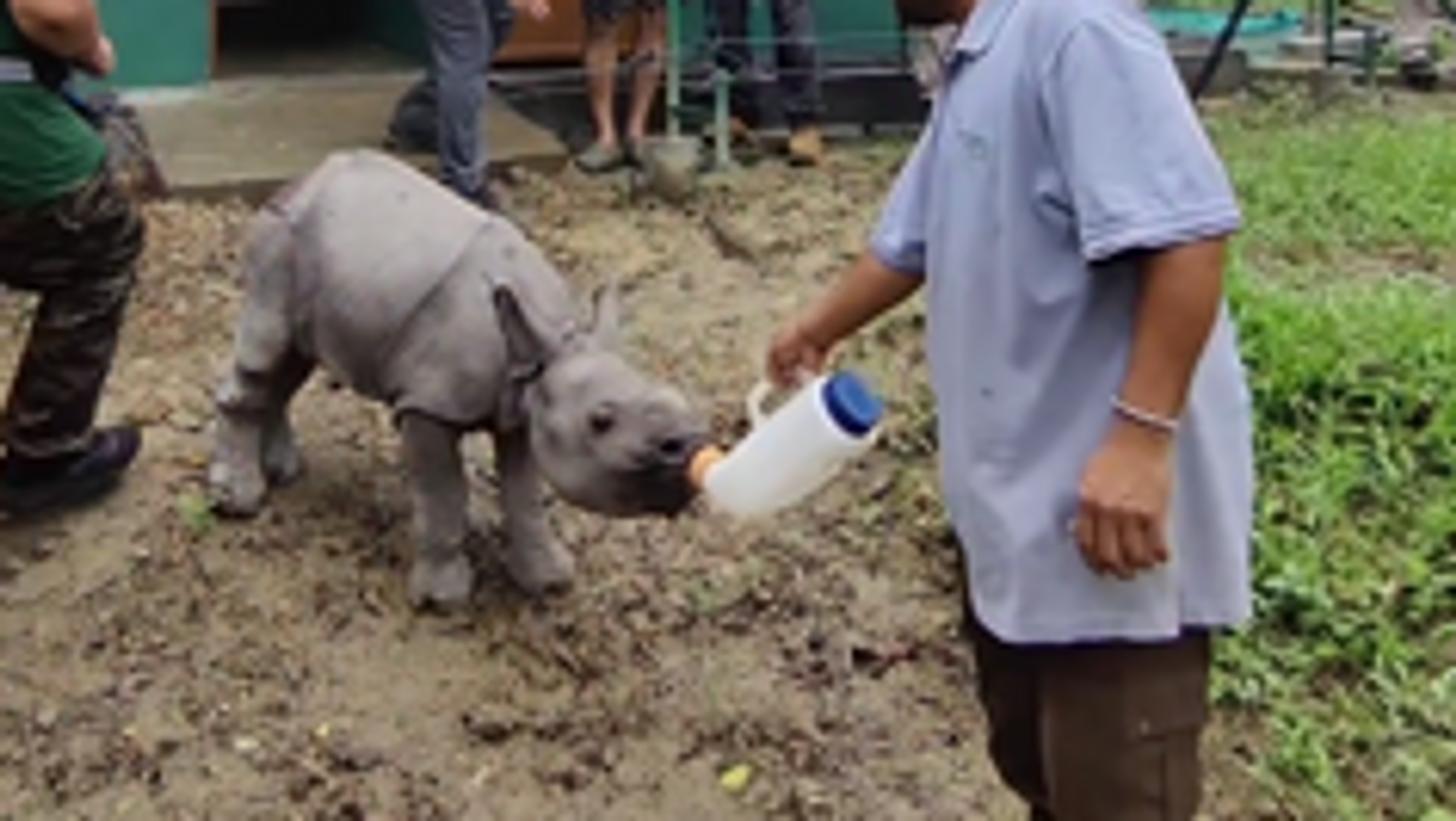https://sputniknews.in/20230922/world-rhino-day-assam-forest-officials-release-rescued-orphaned-calf-4377739.html
World Rhino Day: Assam Forest Officials Release Rescued Orphaned Calf
World Rhino Day: Assam Forest Officials Release Rescued Orphaned Calf
Sputnik India
With a population of around 3,000, India is home to the largest single-horn rhinoceros in the world which is listed as a “vulnerable” species by the International Union for Conservation of Nature Red List of Threatened Species (IUCN) Red List.
2023-09-22T19:47+0530
2023-09-22T19:47+0530
2023-09-22T21:33+0530
india
assam
science & tech
health
nepal
africa
south africa
wildlife
nature conservation
animal extinction
https://cdn1.img.sputniknews.in/img/07e7/09/16/4392828_0:20:236:153_1920x0_80_0_0_51f8e3efae86a86f05713b113dbb302f.png
On Friday, Forest Department officials in the northeastern Indian state of Assam celebrated World Rhino Day by releasing an orphaned one-horned rhino calf into a dedicated rhino paddock at the Center for Wildlife Rehabilitation and Conservation (CWRC).The female baby rhino, aged between two and three months, was rescued last week by the Assam Forest Department from the Pobitora Wildlife Sanctuary and quarantined at the CWRC, which is jointly run by the Wildlife Trust of India (WTI), the Assam Forest Department and the International Fund for Animal Welfare (IFAW) in Assam's Kaziranga.The officials suspected that her mother died near the Haduk beel (lake) area of Pobitora WLS.When rangers spotted the calf, it was lean, starving and dehydrated. Following a 10-day monitoring period, the baby rhino was successfully rescued and transferred to the CWRC. There, a team of veterinarians and keepers nurtured the young animal, preparing it for its return to its natural habitat.Once admitted to the centre, the calf was fed baby formula and tests were carried out to check its health.Dr. Samshul Ali, the centre head at CWRC, told the Indian media that it was no less than a miracle that the calf survived this long.Every year, the world celebrates World Rhino Day on September 22. The theme for this year, "Five Rhino Species Forever" generates a greater understanding and appreciation for the five rhino species that inhabit our planet, namely the Black Rhino, Sumatran Rhino, White Rhino, Indian Rhino, and the Greater One-Horned Rhino.The Government’s initiatives to protect rhinos have resulted in a 38 per cent rise in India’s Rhino population, since 2014.The newly published annual State of the Rhino report by the International Rhino Foundation (IRF) sheds light on the fact that every species of rhino faces an unrelenting threat from poaching.According to the report, there are just over 26,000 rhinos left in the world, all five species combined.According to the report, the population of the greater one-horned rhino in India and Nepal has been increasing. This progress can be attributed to the measures taken to protect them, enforce laws against wildlife crime, and expand their natural habitats.In Africa, the release of 2,000 white rhinos from the "World's Largest Rhino Farm" aims to make a positive impact. However, the battle to protect South Africa's white rhinos from the effects of poaching persists, particularly in the Hluhluwe Imfolozi Game Reserve and other reserves within the KwaZulu-Natal province.Despite constant poaching pressure, black rhino populations are on the rise.On the other hand, the situation of the Sumatran rhino is more distressing. The signs of presence in their natural habitat are becoming harder to find, creating a sense of uncertainty about their population.The Javan rhino population is also in decline. The status and whereabouts of 12 of the 76 remaining Javan rhinos are unknown.
https://sputniknews.in/20230101/tourists-escape-rhino-run-down-in-assam-safari---video-345150.html
india
assam
nepal
africa
south africa
Sputnik India
feedback.hindi@sputniknews.com
+74956456601
MIA „Rossiya Segodnya“
2023
Sangeeta Yadav
https://cdn1.img.sputniknews.in/img/07e6/0c/0f/110602_0:0:641:640_100x100_80_0_0_c298016a79eb02ef8caa9d1f688c12a5.jpg
Sangeeta Yadav
https://cdn1.img.sputniknews.in/img/07e6/0c/0f/110602_0:0:641:640_100x100_80_0_0_c298016a79eb02ef8caa9d1f688c12a5.jpg
News
en_IN
Sputnik India
feedback.hindi@sputniknews.com
+74956456601
MIA „Rossiya Segodnya“
Sputnik India
feedback.hindi@sputniknews.com
+74956456601
MIA „Rossiya Segodnya“
Sangeeta Yadav
https://cdn1.img.sputniknews.in/img/07e6/0c/0f/110602_0:0:641:640_100x100_80_0_0_c298016a79eb02ef8caa9d1f688c12a5.jpg
world rhino day, assam forest officials, rhino calf, single-horn rhino, vulnerable species, international union for conservation of nature red list of threatened species, iucn red list, centre for wildlife rehabilitation and conservation, cwrc, assam forest department, pobitora wildlife sanctuary, wildlife trust of india, wti, assam forest department, international fund for animal welfare, ifaw, kaziranga, formula milk, dr samshul ali, world rhino day theme, five rhino species forever, rhino species, black rhino, sumatran rhino, javan rhino, indian rhino, greater one-horned rhino, rise in india’s rhino population, international rhino foundation, irf, poaching threat, wildlife crime law enforcement, habitat expansion, world’s largest rhino farm, africa, south africa,
world rhino day, assam forest officials, rhino calf, single-horn rhino, vulnerable species, international union for conservation of nature red list of threatened species, iucn red list, centre for wildlife rehabilitation and conservation, cwrc, assam forest department, pobitora wildlife sanctuary, wildlife trust of india, wti, assam forest department, international fund for animal welfare, ifaw, kaziranga, formula milk, dr samshul ali, world rhino day theme, five rhino species forever, rhino species, black rhino, sumatran rhino, javan rhino, indian rhino, greater one-horned rhino, rise in india’s rhino population, international rhino foundation, irf, poaching threat, wildlife crime law enforcement, habitat expansion, world’s largest rhino farm, africa, south africa,
World Rhino Day: Assam Forest Officials Release Rescued Orphaned Calf
19:47 22.09.2023 (Updated: 21:33 22.09.2023) India is renowned for being the habitat of the world's largest single-horn rhinoceros, an awe-inspiring creature that has been marked as a "vulnerable" species on the International Union for Conservation of Nature Red List of Threatened Species (IUCN Red List). There are currently only around 3,000 of these rhinos left.
On Friday, Forest Department officials in the northeastern Indian state of Assam celebrated World Rhino Day by releasing an orphaned one-horned rhino calf into a dedicated rhino paddock at the Center for Wildlife Rehabilitation and Conservation (CWRC).
The female baby rhino, aged between two and three months, was rescued last week by the Assam Forest Department from the Pobitora Wildlife Sanctuary and quarantined at the CWRC, which is jointly run by the Wildlife Trust of India (WTI), the Assam Forest Department and the International Fund for Animal Welfare (IFAW) in Assam's Kaziranga.
The officials suspected that her mother died near the Haduk beel (lake) area of Pobitora WLS.
When rangers spotted the calf, it was lean, starving and dehydrated.
Following a 10-day monitoring period, the baby rhino was successfully rescued and transferred to the CWRC. There, a team of veterinarians and keepers nurtured the young animal, preparing it for its return to its natural habitat.
Once admitted to the centre, the calf was fed baby formula and tests were carried out to check its health.
Dr. Samshul Ali, the centre head at CWRC, told the Indian media that it was no less than a miracle that the calf survived this long.
Every year, the world celebrates
World Rhino Day on September 22.
The theme for this year, "Five Rhino Species Forever" generates a greater understanding and appreciation for the five rhino species that inhabit our planet, namely the Black Rhino, Sumatran Rhino, White Rhino, Indian Rhino, and the Greater One-Horned Rhino.
The Government’s initiatives to protect rhinos have resulted in a 38 per cent rise in India’s Rhino population, since 2014.
The newly published annual State of the Rhino report by the International Rhino Foundation (IRF) sheds light on the fact that every species of rhino faces an unrelenting threat from poaching.
According to the report, there are just over 26,000 rhinos left in the world, all five species combined.
According to the report, the population of the greater one-horned rhino in India and
Nepal has been increasing. This progress can be attributed to the measures taken to protect them, enforce laws against wildlife crime, and expand their natural habitats.
In Africa, the release of 2,000 white rhinos from the "World's Largest Rhino Farm" aims to make a positive impact. However, the battle to protect South Africa's white rhinos from the effects of poaching persists, particularly in the Hluhluwe Imfolozi Game Reserve and other reserves within the KwaZulu-Natal province.
Despite constant poaching pressure, black rhino populations are on the rise.
On the other hand, the situation of the Sumatran rhino is more distressing. The signs of presence in their natural habitat are becoming harder to find, creating a sense of uncertainty about their population.
The Javan rhino population is also in decline. The status and whereabouts of 12 of the 76 remaining Javan rhinos are unknown.



